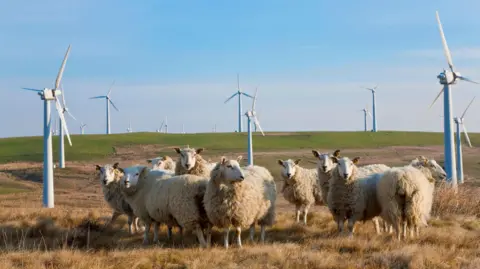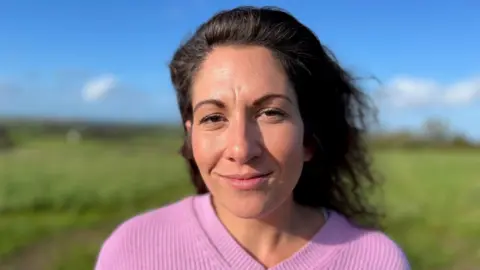Ukraine built more wind farms than Wales despite Russia war – experts

Ukraine Outpaces Wales in Onshore Wind Capacity, Highlighting the Importance of Sustainable Development Goals
Introduction
Despite facing an invasion by Russia, Ukraine has managed to surpass Wales in terms of onshore wind capacity, according to RenewableUK Cymru. This highlights the need for Wales to accelerate its clean power targets and align with the Sustainable Development Goals (SDGs).
Challenges Faced by Wales
RenewableUK Cymru has expressed concerns that Wales is falling behind the rest of the UK in meeting clean power targets. The limited electricity grid capacity and delays in the decision-making process have hindered the development of wind projects in Wales. The Welsh government, however, has prioritized green jobs and growth as part of its agenda.
Ukraine’s Success in Onshore Wind

Despite the ongoing conflict with Russia, Ukraine has successfully built the Tyligulska wind power plant, which generates clean energy for approximately 200,000 homes. This plant, located just 60 miles from the frontline, showcases Ukraine’s commitment to renewable energy. In contrast, Wales has only provided a capacity of 3.2MW through four mini turbines since the beginning of 2023. England, on the other hand, has created 8.3MW since the lifting of the onshore wind ban in 2015.
Call for Urgent Action in Wales
RenewableUK Cymru is urging for urgent action to accelerate the development of wind farms in Wales. Delays in approving projects, such as the Garn Fach wind farm, have hindered progress. The organization is calling for a “four nations renewables team” to ensure Wales does not miss out on opportunities presented by the UK government’s GB Energy initiative. The UK government aims to double onshore wind, triple solar power, and quadruple offshore wind by 2030, aligning with the SDGs of sustainable energy and climate action.

Public Opinion and Job Opportunities
Public opinion on wind and solar farms in Wales is divided. Some, like Sarah Pye from Rhosgoch, Anglesey, express concerns about the visual impact and potential displacement of communities. However, aspiring wind turbine technicians, such as Grace Dennehy and Hollie Massey, see a future in renewable energy and believe there will be ample job opportunities in the sector.
GB Energy and Future Prospects
The success of meeting renewables targets in Wales depends on the implementation of the UK government’s GB Energy initiative. However, there is still uncertainty about the specific impact of GB Energy on Wales. Marine Energy Wales emphasizes the need for Wales to embrace floating offshore wind (FLOW) to avoid falling behind. The Campaign for the Protection of Rural Wales advocates for a focus on offshore wind in the Celtic and Irish Seas. Welsh Secretary Jo Stevens highlights the potential partnership between GB Energy and the Crown Estate to attract private investment for floating offshore wind projects. The Welsh government has already consented to several renewable energy projects and is considering additional proposals.
SDGs, Targets, and Indicators Identified in the Article
1. Sustainable Development Goal 7: Affordable and Clean Energy
– Target 7.1: By 2030, ensure universal access to affordable, reliable, and modern energy services.
– Indicator 7.1.2: Proportion of population with access to electricity.
2. Sustainable Development Goal 13: Climate Action
– Target 13.2: Integrate climate change measures into national policies, strategies, and planning.
– Indicator 13.2.1: Number of countries that have integrated mitigation, adaptation, impact reduction, and early warning measures into their national policies, strategies, and planning.
3. Sustainable Development Goal 8: Decent Work and Economic Growth
– Target 8.5: By 2030, achieve full and productive employment and decent work for all women and men, including for young people and persons with disabilities, and equal pay for work of equal value.
– Indicator 8.5.1: Average hourly earnings of female and male employees, by occupation, age, and persons with disabilities.
Table: SDGs, Targets, and Indicators
| SDGs | Targets | Indicators |
|---|---|---|
| Sustainable Development Goal 7: Affordable and Clean Energy | Target 7.1: By 2030, ensure universal access to affordable, reliable, and modern energy services. | Indicator 7.1.2: Proportion of population with access to electricity. |
| Sustainable Development Goal 13: Climate Action | Target 13.2: Integrate climate change measures into national policies, strategies, and planning. | Indicator 13.2.1: Number of countries that have integrated mitigation, adaptation, impact reduction, and early warning measures into their national policies, strategies, and planning. |
| Sustainable Development Goal 8: Decent Work and Economic Growth | Target 8.5: By 2030, achieve full and productive employment and decent work for all women and men, including for young people and persons with disabilities, and equal pay for work of equal value. | Indicator 8.5.1: Average hourly earnings of female and male employees, by occupation, age, and persons with disabilities. |
Analysis and Explanation
1. The issues highlighted in the article are connected to Sustainable Development Goals 7, 13, and 8. SDG 7 focuses on affordable and clean energy, SDG 13 focuses on climate action, and SDG 8 focuses on decent work and economic growth.
2. Based on the article’s content, the specific targets that can be identified are Target 7.1 (universal access to affordable, reliable, and modern energy services), Target 13.2 (integration of climate change measures into national policies, strategies, and planning), and Target 8.5 (full and productive employment and decent work for all).
3. The article mentions indicators that can be used to measure progress towards the identified targets. For Target 7.1, the indicator is the proportion of the population with access to electricity. For Target 13.2, the indicator is the number of countries that have integrated climate change measures into their national policies, strategies, and planning. For Target 8.5, the indicator is the average hourly earnings of female and male employees, by occupation, age, and persons with disabilities.
The article discusses the lack of electricity grid capacity and delays in decision-making processes in Wales, which hinder the country’s progress in meeting clean power targets. This is relevant to SDG 7 and Target 7.1, as it highlights the need for universal access to affordable and reliable energy services. The article also mentions the UK government’s goal to double onshore wind and quadruple offshore wind by 2030, which relates to SDG 13 and Target 13.2, as it emphasizes the integration of climate change measures into national policies and planning. Additionally, the article mentions the apprenticeship program for wind turbine technicians in Wales, which relates to SDG 8 and Target 8.5, as it highlights the importance of decent work and economic growth in the renewable energy sector.
Overall, the article highlights the challenges and opportunities related to renewable energy development in Wales, and the identified SDGs, targets, and indicators provide a framework for measuring progress and addressing these issues.
Source: bbc.com









